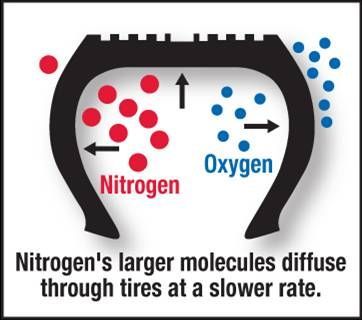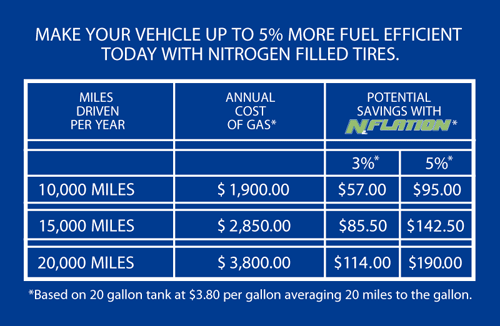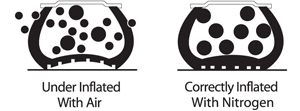Nitrogen Fuel Savings System
Nitrogen Inflation
Nitrogen is a completely safe, non-flammable, inert gas which is in 78% of the air we breathe. We use it instead of air to give your tires maximum performance, and longer tread life. Nitrogen inflation can also save you up to 5% in fuel costs.
We're not the only ones who inflate our tires with nitrogen. It's used by NASA, The U.S. military, commercial airlines and NASCAR and IndyCar teams.
Top 5 Benefits of Nitrogen Inflation:
- Increased fuel efficiency.
- Longer tire tread life.
- Improved tire performance.
- Improved vehicle handling and safety.
- Longer rim life.

Why does Nitrogen Work?
Because of their large size, nitrogen molecules are less permeable than oxygen and stay in your tires longer. It's not necessarily about the nitrogen though. It's more about reducing oxygen, water vapor and other gases in your tires.
By reducing the percentage of oxygen, water vapor and other gases in your tires from 22% to 7% or lower, your tires will maintain proper pressure longer than if you use "plain old air." For example, with 95% nitrogen in your tires, they retain optimal pressure three to four times longer.
Why Increased fuel efficiency?
By maintaining proper tire pressure longer, nitrogen helps keeps the manufacturer's recommended tire “contact patch" on the road. This lessens the rolling resistance and maximizes fuel efficiency.

Why longer tire life?
With nitrogen maintaining more consistent pressure, your tires won't wear as fast on the shoulders from under-inflation or in the center from over-inflation.
Why improved tire performance?
Properly inflated tires ensure that the recommended tire “contact patch" is on the road. This improves your vehicle's handling so you can react more quickly and decisively in potentially dangerous road conditions and situations.
Why improved vehicle handling and safety?
Under-inflated tires cause 90% of blowouts. Nitrogen provides more reliable pressure for reduced blowout potential, greater safety and maximum vehicle handling.
Why longer rim life?
Rim rust is caused by condensation from water vapor and other gases, and can get caught in valves and create slow leaks in tires. It can also damage alloy wheels and cause corrosion. Nitrogen is completely dry, so it eliminates the potential for condensation.
Content provided by the Get Nitrogen Institute. www.getnitrogen.org



